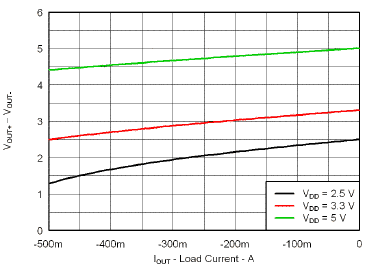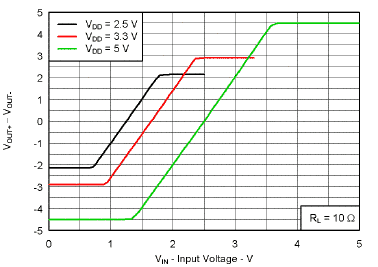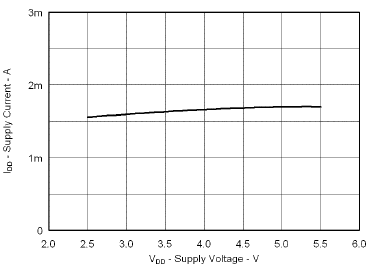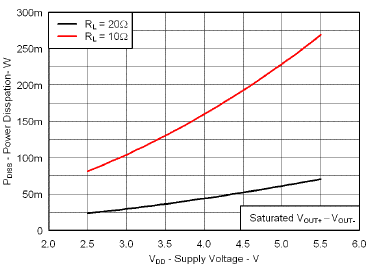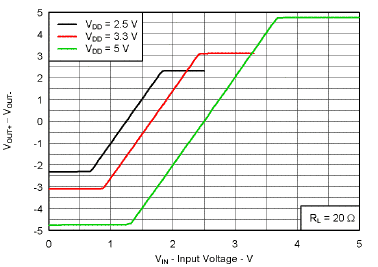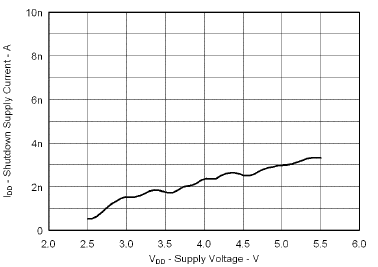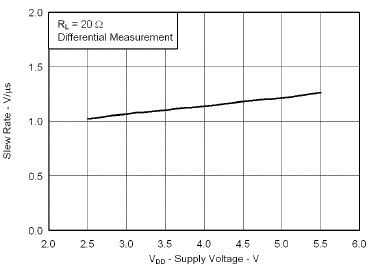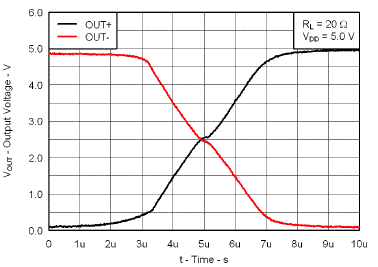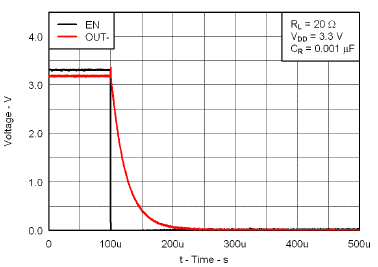SLOS629D July 2010 – October 2016 DRV8601
PRODUCTION DATA.
- 1 Features
- 2 Applications
- 3 Description
- 4 Revision History
- 5 Pin Configuration and Functions
- 6 Specifications
- 7 Detailed Description
- 8 Application and Implementation
- 9 Power Supply Recommendations
- 10Layout
- 11Device and Documentation Support
- 12Mechanical, Packaging, and Orderable Information
Package Options
Mechanical Data (Package|Pins)
Thermal pad, mechanical data (Package|Pins)
- DRB|8
Orderable Information
6 Specifications
6.1 Absolute Maximum Ratings
over operating free-air temperature range, TA ≤ 25°C (unless otherwise noted)(1)| MIN | MAX | UNIT | ||
|---|---|---|---|---|
| VDD | Supply voltage | –0.3 | 6 | V |
| VI | Input voltage, INx, EN | –0.3 | VDD + 0.3 | V |
| Output continuous total power dissipation | See Thermal Information | |||
| TA | Operating free-air temperature | –40 | 85 | °C |
| TJ | Operating junction temperature | –40 | 150 | °C |
| Tstg | Storage temperature | –65 | 150 | °C |
(1) Stresses beyond those listed under Absolute Maximum Ratings may cause permanent damage to the device. These are stress ratings only, which do not imply functional operation of the device at these or any other conditions beyond those indicated under Recommended Operating Conditions. Exposure to absolute-maximum-rated conditions for extended periods may affect device reliability.
6.2 ESD Ratings
| VALUE | UNIT | |||
|---|---|---|---|---|
| V(ESD) | Electrostatic discharge | Human-body model (HBM), per ANSI/ESDA/JEDEC JS-001(1) | ±4000 | V |
| Charged-device model (CDM), per JEDEC specification JESD22-C101(2) | ±1500 | |||
(1) JEDEC document JEP155 states that 500-V HBM allows safe manufacturing with a standard ESD control process.
(2) JEDEC document JEP157 states that 250-V CDM allows safe manufacturing with a standard ESD control process.
6.3 Recommended Operating Conditions
| MIN | NOM | MAX | UNIT | |||
|---|---|---|---|---|---|---|
| VDD | Supply voltage | 2.5 | 5.5 | V | ||
| VIH | High-level input voltage | EN | 1.15 | V | ||
| VIL | Low-level input voltage | EN | 0.5 | V | ||
| TA | Operating free-air temperature | –40 | 85 | °C | ||
| ZL | Load impedance | 6.4 | Ω | |||
6.4 Thermal Information
| THERMAL METRIC(1) | DRV8601 | UNIT | ||
|---|---|---|---|---|
| DRB | ZQV | |||
| 8 PINS | 8 BALLS | |||
| RθJA | Junction-to-ambient thermal resistance | 52.8 | 78 | °C/W |
| RθJC(top) | Junction-to-case (top) thermal resistance | 63 | 155 | °C/W |
| RθJB | Junction-to-board thermal resistance | 28.4 | 65 | °C/W |
| ψJT | Junction-to-top characterization parameter | 2.7 | 5 | °C/W |
| ψJB | Junction-to-board characterization parameter | 28.6 | 50 | °C/W |
| RθJC(bot) | Junction-to-case (bottom) thermal resistance | 11.4 | n/a | °C/W |
(1) For more information about traditional and new thermal metrics, see the Semiconductor and IC Package Thermal Metrics application report.
6.5 Electrical Characteristics
at TA = 25°C, Gain = 2 V/V, RL= 10 Ω (unless otherwise noted)| PARAMETER | TEST CONDITIONS | MIN | TYP | MAX | UNIT | ||
|---|---|---|---|---|---|---|---|
| |VOO| | Output offset voltage (measured differentially) |
VI = 0 V, VDD = 2.5 V to 5.5 V | 9 | mV | |||
| VOD,N | Negative differential output voltage (VOUT+–VOUT–) |
VIN+ = VDD, VIN– = 0 V or VIN+ = 0 V, VIN– = VDD |
VDD = 5.0 V, Io = 400 mA | –4.55 | V | ||
| VDD = 3.3 V, Io = 300 mA | –2.87 | ||||||
| VDD = 2.5 V, Io = 200 mA | –2.15 | ||||||
| VOD,P | Positive differential output voltage (VOUT+–VOUT–) |
VIN+ = VDD, VIN– = 0 V or VIN+ = 0 V, VIN– = VDD |
VDD = 5.0 V, Io = 400 mA | 4.55 | V | ||
| VDD = 3.3 V, Io = 300 mA | 2.87 | ||||||
| VDD = 2.5 V, Io = 200 mA | 2.15 | ||||||
| |IIH| | High-level EN input current | VDD = 5.5 V, VI = 5.8 V | 1.2 | μA | |||
| |IIL| | Low-level EN input current | VDD = 5.5 V, VI = –0.3 V | 1.2 | μA | |||
| IDD(Q) | Supply current | VDD = 2.5 V to 5.5 V, No load, EN = VIH | 1.7 | 2 | mA | ||
| IDD(SD) | Supply current in shutdown mode | EN = VIL, VDD = 2.5 V to 5.5 V, No load | 0.01 | 0.9 | μA | ||
6.6 Operating Characteristics
at TA = 25°C, Gain = 2 V/V, RL = 10 Ω (unless otherwise noted)| PARAMETER | TEST CONDITIONS | MIN | TYP | MAX | UNIT | |
|---|---|---|---|---|---|---|
| ZI | Input impedance | 2 | MΩ | |||
| ZO | Output impedance | Shutdown mode (EN = VIL) | >10 | kΩ | ||
6.7 Typical Characteristics
Table 1. Table of Graphs
| FIGURE | ||
|---|---|---|
| Output voltage (High) | vs Load current | Figure 1 |
| Output voltage (Low) | vs Load current | Figure 2 |
| Output voltage | vs Input voltage, RL = 10 Ω | Figure 3 |
| Output voltage | vs Input voltage, RL = 20 Ω | Figure 4 |
| Supply current | vs Supply voltage | Figure 5 |
| Shutdown supply current | vs Supply voltage | Figure 6 |
| Power dissipation | vs Supply voltage | Figure 7 |
| Slew rate | vs Supply voltage | Figure 8 |
| Output transition | vs Time | Figure 9, Figure 10 |
| Startup | vs Time | Figure 11 |
| Shutdown | vs Time | Figure 12 |
